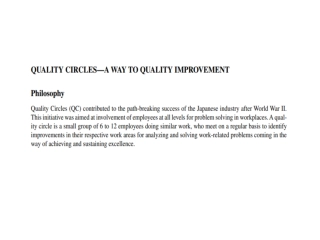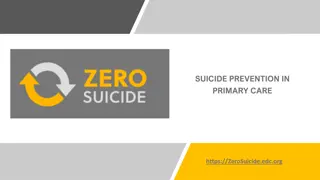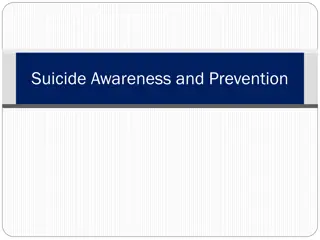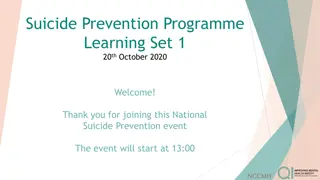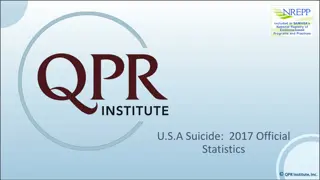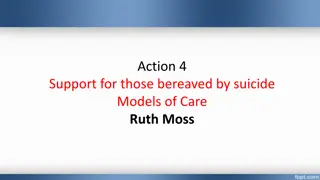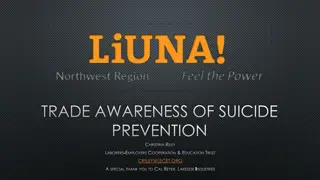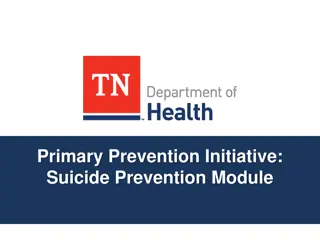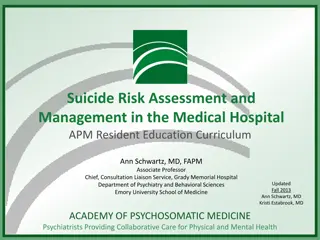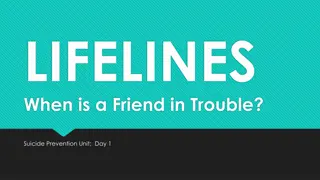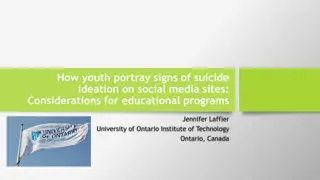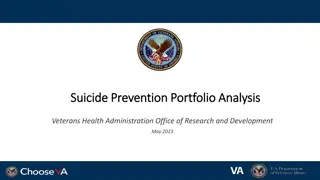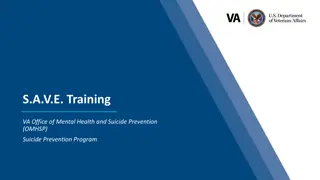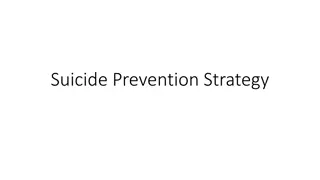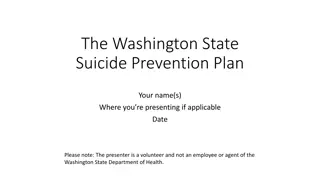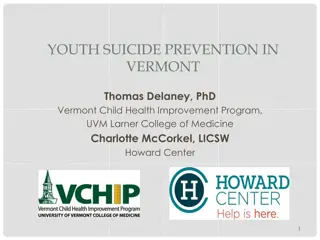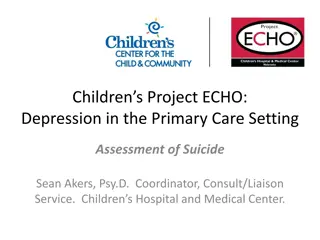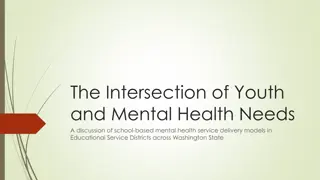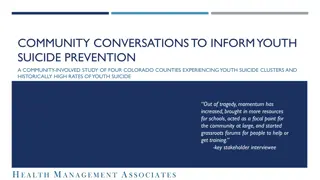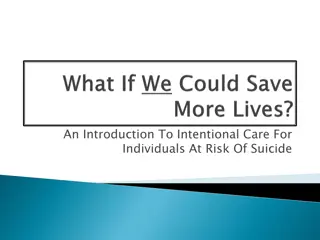Zero Suicide Initiative: A Commitment to Suicide Prevention in Healthcare Settings
Zero Suicide Initiative is a core concept of the National Strategy for Suicide Prevention, emphasizing the prevention of suicide deaths for individuals in healthcare systems. It involves promoting patient safety, supporting clinical staff, and implementing effective practices for assessing and treating those at risk. The initiative strives to reduce rates of suicidal ideation, attempts, and deaths through leadership-driven culture, workforce development, systematic risk assessment, care management plans, evidence-based treatments, continued support, and data-driven quality improvement.
Uploaded on Sep 24, 2024 | 0 Views
Download Presentation

Please find below an Image/Link to download the presentation.
The content on the website is provided AS IS for your information and personal use only. It may not be sold, licensed, or shared on other websites without obtaining consent from the author. Download presentation by click this link. If you encounter any issues during the download, it is possible that the publisher has removed the file from their server.
E N D
Presentation Transcript
Zero Suicide Initiative A commitment to suicide prevention in health care and behavioral healthcare settings
What is Zero Suicide? Zero suicide is a key concept of the 2012 National Strategy for Suicide Prevention, a priority of the National Action Alliance for Suicide Prevention, a promoted project through SPRC, and supported by the Substance Abuse and Mental Health Services Administration (SAMHSA) Zero Suicide is a foundational belief that suicide deaths for individuals under care within health and behavioral health care systems are preventable. Within health care systems, the Zero Suicide approach represents a commitment to: -To patient safety, the most fundamental responsibility of health care -To the safety and support of clinical staff, who do the demanding work of treating and supporting suicidal patients
2012 National Strategy for Suicide Prevention: GOALS AND OBJECTIVES FOR ACTIONS a report of the U.S. Surgeon General and of the National Action Alliance for Suicide Prevention Goal 8: Promote suicide prevention as a core component of health care services. Goal 9:Promote and implement effective clinical and professional practices for assessing and treating those at risk for suicidal attempts and behaviors Garrett Lee Smith Youth Suicide Prevention Grant Goals: Goal 6: Comprehensively implement sections of the 2012 National Strategy for Suicide Prevention to reduce rates of suicidal ideation, attempts, and deaths in local communities
7Essential Elements of Suicide Care (as identified by the Action Alliance s Clinical Care and Intervention Task Force) LEAD: Create a leadership-driven, safety-oriented culture committed to dramatically reducing suicide among people under care. TRAIN: Develop a competent, confident, and caring workforce. IDENTIFY: Systematically identify and assess suicide risk among people receiving care ENGAGE: Ensure every person has a suicide care management plan or pathway to care that meets the client s needs. This includes safety planning and lethal means restriction. TREAT: Use effective, evidence-based treatments that directly target suicidality. TRANSITION: Provide continued contact and support, especially after acute care. IMPROVE: Apply a data-driven quality improvement approach to inform system changes that will lead to improved patient outcomes and better care for those at risk.
How do we Lead and Train? LEAD Train Engage Leadership, CEO s, decision makers, funders, and supporting committees within agencies willing to support Zero Suicide Promote, implement, host, and assist in organization of best practice trainings with organizations willing to adopt Zero Suicide Review safety standards of each organizations to see how zero suicide could fit in to an organization AMSR Include suicide attempts and loss survivors in leadership and planning roles Find a champion at each organization to help promote and implement C.A.L.M.
How do we Identify and Engage? Identification happens when an agency is able to systemically identify and assess suicide risk among people receiving care. This includes consistently using best practice screening tools to assess and manage suicide risk. Engagement happens when an agency is willing to ensure that every client has a suicide care management plan or a pathway to care that is timely and adequate to meet the client s needs. This includes collaborative safety planning and restrictions to lethal means.
Columbia-Suicide Severity Rating Scale SUICIDE IDEATION DEFINITIONS AND PROMPTS Ask questions that are bolded and underlined. Ask Questions 1 and 2 1) Wish to be Dead: Person endorses thoughts about a wish to be dead or not alive anymore, or wish to fall asleep and not wake up. Have you wished you were dead or wished you could go to sleep and not wake up? Some Healthcare systems have worked to automatically link the EHR to C-SSRS. "It's a forced choice. You cannot sign and complete the EHR until you have also done the C-SSRS." 2) Suicidal Thoughts: General non-specific thoughts of wanting to end one s life/commit suicide, I ve thought about killing myself without general thoughts of ways to kill oneself/associated methods, intent, or plan. Identify Have you actually had any thoughts of killing yourself? The C-SSRS also is activated whenever a red flag is raised in the provision of care, such as a trauma patient talking about escalated drinking and negative thinking. If YES to 2, ask questions 3, 4, 5, and 6. If NO to 2, go directly to question 6. 3) Suicidal Thoughts with Method (without Specific Plan or Intent to Act): Person endorses thoughts of suicide and has thought of a least one method during the assessment period. This is different than a specific plan with time, place or method details worked out. I thought about taking an overdose but I never made a specific plan as to when where or how I would actually do it .and I would never go through with it. Dr. McCall, Chairman of the Dept. of Psychiatry and Health Behavior at the Medical College of Georgia at Georgia Regents University Have you been thinking about how you might kill yourself?
Risk formulations such as this one, when used in a health care setting will assist staff in identifying the indicated level of risk
Engagement happens through patient- provider collaboration on safety and treatment All patients with suicide risk should have a safety plan in hand when they leave care. Safety planning is collaborative and includes: lethal means restriction, communication with family members and other caregivers, and regular review and inclusion in the plan
How do we Treat and Transition? Suicidal patients are often successfully treated when suicidal thoughts, feelings and behaviors are treated directly with effective, evidence-based treatment models. CBT DBT Successful transitions happen when agencies follow patients through their transitions of care and provide continuous contact, resources, and support, especially after acute care. (Collaborative Assessment and Management of Suicidality)
How do we Improve? Agencies adopting Zero Suicide who apply a data driven approach to inform system changes, will have significantly improved patient outcomes and will provide better care for those at risk Data collection evaluations are available to all agencies wishing to implement Zero Suicide, it is challenging to improve without a starting point! So where do we start?
Prior to making plans to implement Zero Suicide, each organization should find a Champion and complete and organizational self-study with others from the organization ORGANIZATIONAL SELF STUDY What s a champion? A Zero Suicide champions pursue safer, more effective suicide care approaches in health care systems and know that reducing suicides for those at risk is achievable. Champions see that gaps exist in the delivery of care to those at risk for suicide and advocate for health and behavioral health care organizations to provide more comprehensive and evidence-based care.
Create an Implementation Team! Meet monthly and as needed All team members should know it is a 1 year commitment Team members should have a passion for suicide prevention and client care Functions: Maintain organizational commitment and enthusiasm Draft and implement work plan for Zero Suicide Determine how to address gaps (from self-study), create goals, and identify needs Evaluation initiative, with a focus on continuous quality improvement
Is your agency ready to get started? Do you have questions regarding Zero Suicide? Great! Contact Jill Jeter Youth Suicide Prevention Coordinator at Jackson County Mental Health jeterjn@jacksoncounty.org or call 541-770-7776


